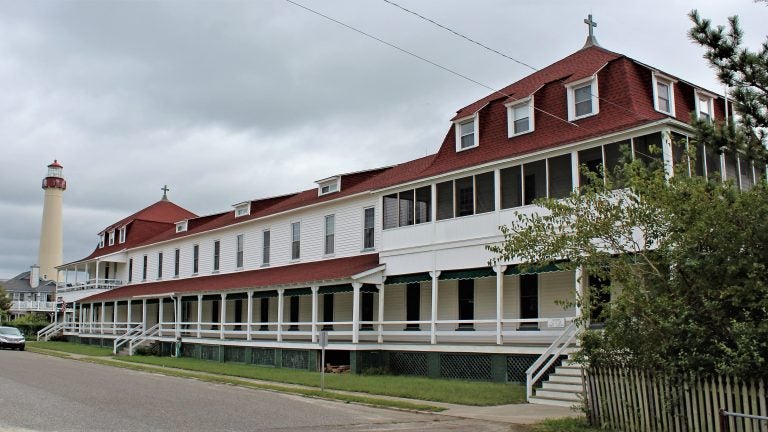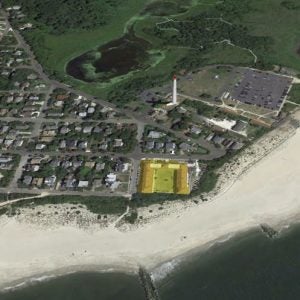Nuns plan to demolish Cape May Point retreat center
An iconic building owned by nuns may be returned to nature.

The St. Mary By-The-Sea Retreat House in Cape May Point. (Bill Barlow/for WHYY)

An iconic building that has stood near the beach for more than a century in Cape May Point will be demolished in a few years under a plan announced by the owners, the Sisters of Saint Joseph in Chestnut Hill, Philadelphia.
The religious order has owned the rambling Saint Mary by-the-Sea at 101 Lehigh Ave. since 1909, using it as a retreat house for members and others. That use is set to continue until 2021, but after that, the plan is to return the beachfront property to nature.
Cecilia W. Rupell, a spokeswoman for Sisters of Saint Joseph, said the nuns are convinced that the property should be kept from development and the existing building knocked down.
Along with the Cape May Lighthouse just down the street – which is actually in Lower Township but casts a long shadow across tiny Cape May Point – and Saint Peter’s-by-the-Sea Episcopal Church, Saint Mary is one of the most recognizable buildings in the borough.
“It’s certainly iconic when you talk about Cape May Point. That and the lighthouse right behind it,” Rupell said.
But the building is expensive to maintain and the membership of the Sisters of Saint Joseph is dwindling.
“It’s with a heavy heart that the consensus was that it’s time to let go,” Rupell said. The order’s ethos calls for the property to be returned to nature, she said, an ideal of land stewardship to which the members are deeply committed.
“They’re waiting for the right person, organization or institution to come along and answer that need,” she said.
Robert Mullock, one of the three members of Cape May Point’s governing Board of Commissioners, has been working with the religious order on plans for the building. The discussions are still underway, he said in a recent interview.
“We expect to be involved in that planning process over the next couple of years,” he said. It will likely be four or five years before any changes are made to the property.
He said he will be sorry to see the end of the retreat house, saying the nuns and their guests have been a terrific part of Cape May Point.
“They’ve been wonderful members of the community,” he said. “They’ve been very probably the best neighbors we could possibly have for that site.”
But while both Mullock and the sisters say the property has been maintained through the decades, he said it does not meet current standards. Mullock and his family own the historic Chalfonte Hotel in nearby Cape May City, which he said shows he understands the challenges of preserving historic buildings. Citing rising sea levels, he said the building would not withstand the impact of a future hurricane.
“People around here believe it’s been protected by a higher power so far,” he said.
Rupell made a similar observation.
“There is a statue of Mary in the courtyard. Every time there’s a hurricane or flooding, it never gets by the base of that statue. We like to think that’s her doing,” she said.
What it’s used for

The building is in use from June through September each year, a home for silent retreats and directed retreats “designed to meet the needs of those who desire to step back from the daily pace of life to encounter God anew,” as Rupell put it. The retreats are not restricted to the nuns, or even to Catholics, she said, mentioning a Presbyterian organization also uses the facility.
“It’s there for anyone,” she said.
Unlike Cape May, there is no historic preservation ordinance in Cape May Point, meaning it is entirely up to the owners to decide the future of the property. According to Mullock, a property that size right against the dunes would be a boon to Cape May Point as a natural area. He cited the borough as one of the most important migration routes for birds of prey and for monarch butterflies.
On a cool, sunny October morning, it was easy to see what he meant, with Cooper’s hawks and sharp-shinned hawks hunting in the pines along the dunes and dozens of butterflies gathering in the late-blooming goldenrod along the beach near the site.
“In many other places, it wouldn’t be that critical to have it as open space. But in Cape May Point, that is a genuinely appreciated option that the sisters have presented to the community,” Mullock said.
Campaign to ‘Save’ the building
Not everyone welcomes the plan. Resident John Reilly has been campaigning to save the building, which he sees as a rare thing of beauty. He said he’s troubled by the prospect that the work of artisans and builders from a century ago could end up being demolished.
“It’s a beautifully landscaped building that’s been there forever,” Reilly said. He suggests some neighbors would like to see it demolished to improve their views.
“To me, there’s nothing wrong at all with this building,” he said. “If Cape May Point had historic preservation on their books they wouldn’t be able to touch that building.”
According to Mullock who sits on the Board of Commissioners, there may be other possibilities for the property. “We continue to have discussions with them,” he said. “But we’ve like to keep those discussions private until a decision has been made.”
Under Cape May Point zoning, it could not return to use as a hotel, he said. In fact, he did not believe any commercial use would be allowed. The borough is less than a square mile, with a single commercial use for a restaurant and general store.
Before the nuns
The retreat overlooks where the Atlantic Ocean mingles with the Delaware Bay. According to Rupell, with the Sisters of Saint Joseph, it was originally built in 1889 and operated for nearly a decade as the Shoreham Hotel. There were 150 rooms, 1,200 feet of porches and a lawn that lead down to the ocean long before the dunes built up. But within the decade, changing times mean the oceanfront hotel was no longer viable.
In 1898 it operated as the “Home for Aged and Infirmed Colored People.”
“It didn’t work out real well,” Rupell said. The Sisters of Saint Joseph purchased the property for $9,000.
“The building was left pretty much as it was. They added crosses to the roof and turned the ballroom into a chapel,” she said.
For now, there is no deal with any organization to take over the property, Rupell said.
WHYY is your source for fact-based, in-depth journalism and information. As a nonprofit organization, we rely on financial support from readers like you. Please give today.





